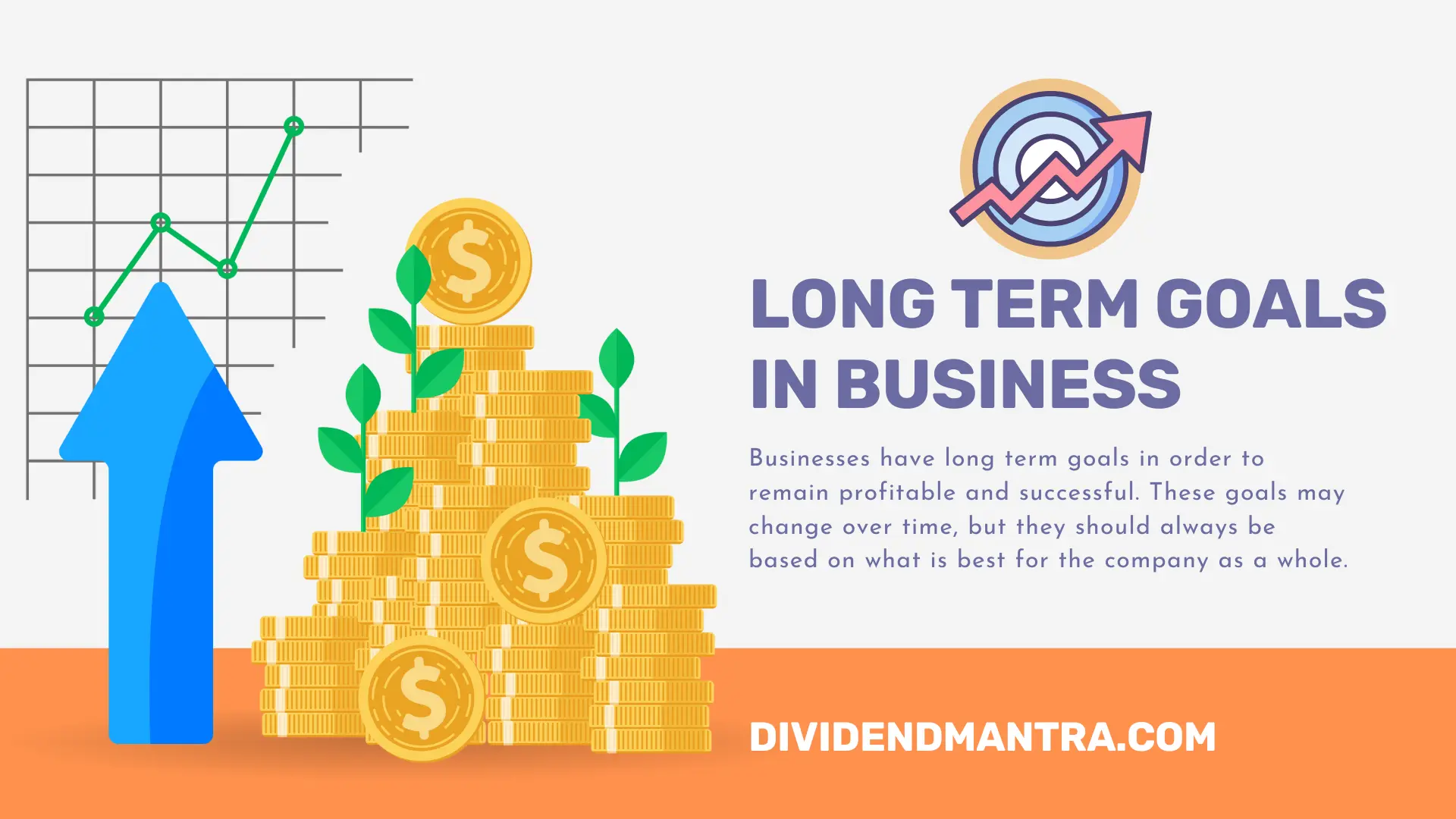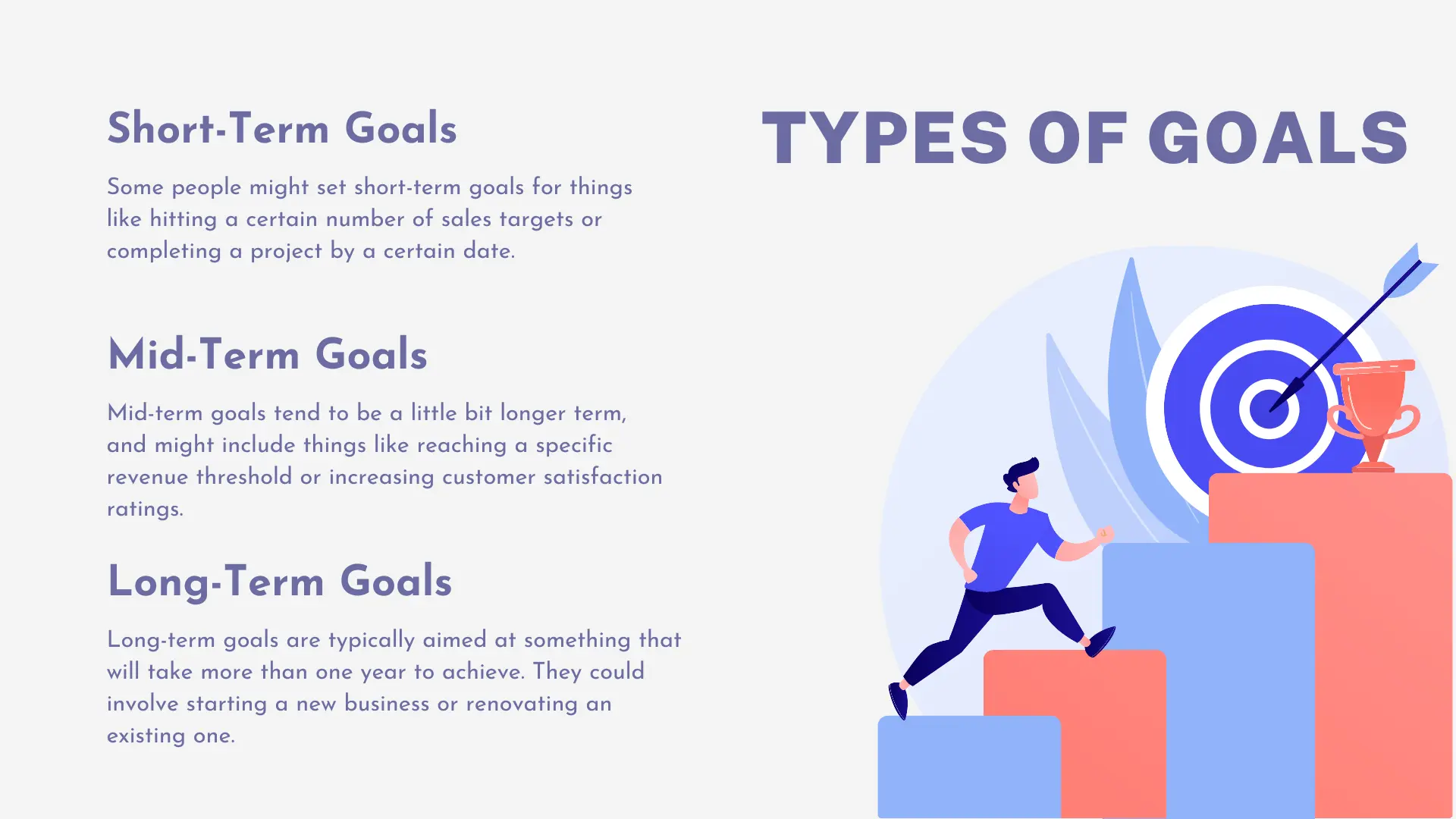Long Term Goals in Business
Businesses have long term goals in order to remain profitable and successful. These goals may change over time, but they should always be based on what is best for the company as a whole. Some common long term goals are to increase sales, decrease costs, improve customer service, and increase shareholder value.
There are a number of factors to consider when setting long-term business goals. Some important questions include:
- What is your company’s purpose?
- What are your key market segments?
- What are the most important trends affecting your industry?
- What opportunities do you see for growth in your industry?
- What strategies will help you achieve all of the above?
If you want to be a successful business owner, it is important to have these questions in mind. While it can be tempting to focus on the here and now, taking a step back and thinking about your core goals will help you stay on track and make better decisions.
In this article, we will show you some tips for setting long-term goals.
What Are Long-Term Business Goals?
A long-term business goal is something that we hope to achieve over a period of time, typically greater than one year. It can be something as simple as making a profit, or as complex as becoming the top company in a particular industry.
Businesses have traditionally operated on a short-term goal-setting model. This approach works for businesses that are able to meet quarterly or annual goals, but it can be difficult to maintain when the business environment becomes unpredictable or when new challenges arise. A long-term goal-setting model is more sustainable because it addresses the underlying drivers of success and provides a road map for reaching the company’s objectives.
There are several advantages to using a long-term goal-setting model:
- It provides clarity and certainty for employees and stakeholders.
- It allows for better planning and avoids unnecessary risks.
- It leads to improved decision making, as managers can better gauge their progress towards objectives.
- It allows businesses to adapt more easily to changes in the market or competition.
- It encourages flexibility and empowerment in the workforce.
- It helps to meet the needs of business growth.
Types of Goals: What Are Some Common Types of Goals?
There are many types of goals, but they can generally be broken down into three categories: short-term, mid-term, and long-term. Here are some examples of each:
i. Short-Term Goals
Some people might set short-term goals for things like hitting a certain number of sales targets or completing a project by a certain date.
ii. Mid-Term Goals
Mid-term goals tend to be a little bit longer term, and might include things like reaching a specific revenue threshold or increasing customer satisfaction ratings.
iii. Long-Term Goals
Long-term goals are typically aimed at something that will take more than one year to achieve. They could involve starting a new business or renovating an existing one.
It’s important to remember that not all goals need to be ambitious – sometimes it’s enough just to make some small progress towards them.
Setting and Monitoring Goals: How Do You Set and Monitor Goals?
Setting and monitoring business goals can be a difficult task. However, with the right tools and techniques, it can be a relatively easy process. There are a number of different ways to set goals, and each has its own advantages and disadvantages. Some people prefer to write down their goals upfront, while others prefer to develop them over time as they become clearer. Regardless of how you approach goal setting, the most important step that you need to take in order to ensure successful achievement is to identify your objectives or goals.
These should be specific, measurable, achievable, relevant and time-bound (SMART). Once you have identified your objectives, you then need to create a plan of action (POA) that will help you achieve them.
Goal Orientation: How Important Is Goal Orientation to Success?
The goal orientation of a business is an important factor in its success. A company with a clear and attainable goals will be more motivated to achieve them, leading to greater productivity and profitability. In order to achieve these goals, businesses must have a clear sense of what they want and how they plan on getting there. Without a strong goal orientation, businesses can become bogged down by their own ambitions, resulting in inaction or even failure.
The Importance of Planning: What Is the Importance of Planning for Long Term Business Goals?
Planning is an important aspect of any business. When done correctly, it can help you achieve your long-term goals. Planning can also help you avoid potential problems and make better decisions.
Here are four reasons why planning is so important:
i. It Allows You to Prioritize Your Efforts
When you plan, you can focus your efforts on the most important tasks. This will ensure that you’re able to achieve your goals as quickly as possible.
ii. It Allows You to Predict Changes in the Market
If you plan ahead, you’ll be better prepared for changes in the market. This will allow you to make smarter business decisions and keep pace with the competition.
iii. It Prevents Potential Problems from Becoming Realities
If you don’t plan, problems may become realities.
Tips for Setting Long-Term Goals
Achieving long-term goals in business is essential for success. Without a plan, it’s easy to get sidetracked, and it can be difficult to stay on track when the going gets tough. Here are tips for setting and achieving long-term goals:
1. Understand What Type of Business You Run
If you’re not sure what type of business you’re in, it’s time to take a step back and figure it out. The following tips will help you do just that.
i) Define your company’s purpose. What are you trying to achieve? What is your target market? Once you know these things, your business goals can be more specific and achievable.
ii) Think about the resources you have at your disposal. What extent of freedom do you have in setting the direction of your company? Are there any constraints such as financial or legal restrictions? Once you understand these limitations, it will be easier to make informed decisions about where to allocate your resources.
iii) Evaluate how well your company is performing right now. Are there any areas where progress could be made? Are there any issues that need to be addressed immediately?
2. Research the Best Methods for Marketing and Selling Your Product or Service
To be successful in marketing and selling your product or service, it is important to employ the right methods. This can be a difficult task, but there are many different ways to go about it.
One of the most important things you can do is research the best methods for reaching your target audience. This will help you to determine which channels work best for you and which strategies will produce the most results.
You also need to make sure that your marketing efforts are consistent and effective over time. This means setting realistic goals and planning campaigns accordingly.
Finally, always keep in mind that it takes hard work and dedication to succeed in this field. Don’t give up too soon – research the best methods for marketing and selling your product or service today!
3. Develop Relationships With Key Stakeholders and Customers
Developing relationships with key stakeholders and customers is essential for setting long-term business goals. By understanding the needs of these groups, you can create products and services that are demanded and appreciated. Here are some tips for building fruitful relationships:
i. Listen carefully. Make sure to really listen to what your key stakeholders and customers have to say. Do not assume that you know everything, or that what you think is best is always what they want. Instead, be open to their ideas and suggestions. This will help you build trust and confidence in each other.
ii. Be proactive. Don’t wait for someone to come to you with a problem or concern. Be proactive in seeking out feedback and addressing any issues head on.
4. Always Actively Seek To Create Relationships With New Clients and Customers
Creating relationships with new clients and customers is essential to setting long-term business goals. By actively seeking out new relationships, you can build trust and confidence with potential customers, which will help you sell more products and services. Additionally, building strong ties with new customers can lead to future business opportunities. Here are some tips to help you stay connected with your new clients:
i. Make a point to meet with your new clients regularly. This will help you get to know them better and build trust.
ii. Send them customer-focused emails and newsletters. This will keep them updated on the latest news and events related to your business.
iii. Offer discounts or special offers to your new clients frequently. This will show them that you appreciate their business and encourage them to return in the future.
5. Cultivate a Loyal Following
Running a business is a daunting task, but it can be made easier with the right tools and strategies. One of the most important things you can do is cultivate a loyal following. This will help you to set long term business goals and stay focused on your goals, no matter what obstacles come your way.
Loyal followers are people who are dedicated to your brand and will continue to support you even in difficult times. By building a loyal following, you can tap into their knowledge and resources, and turn them into customers and advocates for your business.
There are many ways to create a loyal following for your business. Some popular methods include social media marketing, content marketing, and public relations campaigns. Whichever approach you choose, make sure that it is consistent with your brand’s vision and values.
6. Manage Expenses and Stay on Budget To Reach
When setting business goals, it is important to keep in mind both short and long term objectives. For example, if your goal is to increase sales by 10%, you may want to take into account other factors such as the company’s budget and how much time you have available.
Managing expenses can also be helpful in reaching your larger business goals. By knowing how much money you are spending each month, you can better plan for future expenses. Additionally, being aware of your current expenses can help you make better decisions when it comes to purchasing new equipment or expanding your business.
One way to manage expenses is to create a budget. This will help you determine how much money is available each month for purchasing items or operating costs. Once a budget has been created, it can be useful to track actual spending so that adjustments can be made as needed.
7. Develop a Clear and Concise Business Plan
If you want to keep your business on track and achieve your long-term goals, developing a clear and concise business plan is a very useful tool. By breaking down your business operation into manageable steps and ensuring that each step is linked back to the overall goal, you can create a roadmap that will help you stay on track.
When creating your plan, it’s important to remember that not all businesses are the same. Some may require more detailed planning than others, but by following these basic tips, you’ll be well on your way to developing a successful business plan:
i. Define Your Mission Statement
Your mission statement should provide a succinct explanation of what your business does and why it matters. This will help you stay focused as you develop your plans and ensures that your company remains aligned with its goals.
ii. Develop a Business Plan
You can start developing your business plan by taking into consideration the following:
A. Company History: The company history should include details about its founding, how it started and what made the business successful in the past.
B. Develop a 5 Year Business Plan: This should include an assessment of the company’s current position, its strengths and weaknesses, and a prediction of how these will change over the next 5 years. The plan should also identify what resources will be needed to realize the desired results and how these will be acquired.
C. Develop a 10 Year Business Plan: A 10-year business plan is a strategic document that lays out an organization’s vision, mission, goals, and objectives. It should be comprehensive and provide a roadmap to achieve the organization’s desired outcomes over the next ten years. The plan should be updated at least once per year and include financial data, performance metrics, and changes in the competitive landscape.
D. Develop a 20 Year Business Plan: A 20-year business plan should outline the company’s strategic goals and objectives, identify any key challenges and opportunities facing the business, and document how the company plans to achieve its objectives. It should also include a financial analysis of the company’s health and profitability over the next decade, as well as a review of how the company has evolved since its inception. A comprehensive business plan can provide valuable guidance to future decisions and help ensure that a company remains successful over the long term.
8. Create Objectives
Creating objectives can be a difficult task, but by following some simple steps, you can make the process much easier. By setting specific goals for your business, you can ensure that it continues to grow in the future. Here are some tips on how to create effective objectives:
i. Define your business goals. Start by defining what you want your business to achieve in the future. This could be anything from increasing sales figures to becoming more competitive in the market. Once you have defined your goals, it is important to break them down into smaller, more manageable tasks.
ii. Set realistic deadlines for each goal. It is important to set deadlines for each of your business goals so that you know when you need to start working towards them.
9. Define What Success Means to You
For most people, success means different things at different stages in their lives. When you’re just starting out, your definition may be much more straightforward – making a lot of money, being famous, or achieving any other lofty goal. But as you get older and have more experience under your belt, your definition of success may start to evolve. You may start to appreciate the finer things in life – like having a fulfilling relationship, enjoying leisure time activities, and feeling confident in who you are. Or you may want to achieve tangible goals that will improve the quality of your life immediately (such as becoming debt free or owning a house). The important thing is that you define what success means to you and make sure that your long-term business goals reflect this definition.
10. Set Timelines and Milestones – Be Realistic With Your Expectations
Setting timelines and milestones is an essential part of any successful business. However, if you’re not realistic with your expectations, you’ll end up frustrated and disappointed. Here are some tips to help you stay on track:
i. Define your goals and target dates early on in the project. Don’t wait until the last minute to try to cram in additional tasks. This will only create more stress and chaos.
ii. Make sure that all team members are on the same page with regards to timeline goals and deadlines. If one person is pushing back, it can throw off the entire project schedule.
iii. Accept that things may go a little slower than anticipated at times – this is normal! Don’t start second guessing yourself or give up prematurely – this will only set you back further down the line.
11. Get Help From a Professional
If you want to set long-term business goals, it’s important to get help from a professional. By working with an advisor, you can bypass the cognitive bias of sunk costs and make more informed decisions about your company’s future. One downside of not getting help is that it can be difficult to stay focused on your long-term goals. However, by following some tips for finding an advisor, you’ll be on your way to success.
i. Start by researching different advisors. There are many different types of advisors, so it’s important to find someone who will best suit your needs. Look online by simply typing “Professional Business Advisors,” or, “leading provider of business advice in the USA,” for a list of professionals who could help you out.
ii. Consider your budget and timeline. Not all advisors are affordable and not all timelines are short or long term.
12. Maximize Efficiency in Your Office
Maximizing Efficiency in Your Office can help you to set long term business goals. Some key tips include setting daily and weekly goals, creating systems and procedures, and establishing guidelines. Daily and weekly goals help you to stay focused on your objectives, create systems that will help you track progress, and establish guidelines that will keep you accountable. Creating systems and procedures can save time and energy while ensuring that your work is organized and consistent. Establishing guidelines can ensure that everyone in your office follows the same standards, thus reducing confusion and inconsistencies. By utilizing these tips, you can maximize efficiency in your office while achieving your desired long term results.
13. Don’t Deviate From Your Long Term Business Strategy Except It Shows No Signs of Working
Business owners often find themselves in a difficult situation where they are unsure of what is the right course of action to take. This can be especially true when it comes to setting long-term business goals, as there can be many different ways to achieve success. However, following a strict strategy that has been successful in the past is one of the best ways to ensure your business remains afloat and profitable. If you find yourself deviating from this strategy, it may be time for you to reevaluate your goals and make some changes.
However, not changing your strategy even when your business is failing is a bad idea. In any case, it is important to take things slow and make sure that your long-term strategy is really not working before making any drastic changes.
14. Identify and Pursue Long Term Business Opportunities
If you want to be successful in the long term, it’s important to have a clear idea of what you want and where you see yourself in the future. This can be tricky, especially if you’re not sure where to start. One great way to get started is by identifying your long term business opportunities.
There are many different ways to find these opportunities, but one of the most effective methods is to review your current business and assess where you could improve. Once you have a good understanding of where your business could grow, it’s time to start pursuing potential deals and partnerships.
By taking the time to identify and pursue long term business opportunities, you’ll set yourself up for success in the future.
15. Build a Successful Long Term Business Brand
When it comes to building a successful long term business brand, there are a few key things you need to keep in mind. As we have mentioned above, one of the most important things is setting goals for yourself and your company. Without specific goals, it can be easy to get lost and drift along without any real focus or direction. By setting specific milestones and targets, you can help ensure that your business remains on track and achieves its ultimate objectives.
Additionally, establishing strong relationships with customers and partners is another key factor when it comes to building a successful long term business brand. by consistently providing value and being friendly and helpful, you will be able to build trust and improve customer loyalty over time, and build up a recognisable brand.
Finally, never forget about marketing yourself as a legitimate business entity – make sure you are using the right marketing channels in order to reach your target audience effectively.
16. Create and Maintain a Successful Long Term Business Culture
Creating and maintaining a successful long term business culture is an important task. Here are some tips to help you achieve success:
i. Set long term business goals for your team. Make sure your goals are achievable, but also stretch yourself and your team beyond what you think is possible. Achieving goals that are challenging but not impossible will lead to greater satisfaction and motivation among your employees.
ii. Encourage employee creativity and innovation. This can be done by allowing employees to express themselves freely, giving them the opportunity to develop new ideas, and providing them with resources they need to succeed. This will encourage them to explore different potential solutions and make their own contributions to the company.
iii. Foster mutual respect among team members. Building a strong sense of community within your workplace is essential for success in the long term.
17. Set Small Goals Along the Way That Will Help You Reach Your Overall Objective
The key to achieving any longterm goal is setting small goals along the way that will help you reach your overall objective. By doing this, you will create momentum and ensure that you stay on track. Here are three tips for setting small goals that will help you achieve your larger goal:
i. Make sure the goals are achievable. If the goal is too big or out of reach, it will be difficult to motivation yourself to reach it. Set smaller goals that are within your capabilities and make sure they have a clear deadline.
ii. Give yourself time to achieve the goal. It may take longer than you initially thought to complete the goal, but this is okay—all progress is important in achieving a successful outcome. Allow yourself enough time to make some tangible progress and celebrate when you reach your milestones along the way.
iii. Celebrate the achievement. This can be a fun and light-hearted moment, it doesn’t have to be serious or boring. Celebrating your success is the best way to keep yourself motivated and excited about the larger goal you are working towards.
18. Reward Yourself for Reaching Milestones Along the Way!
Many people feel that reaching milestones in their business is a sign that they are progressing and their work is worth doing. However, often times people forget to reward themselves for reaching these milestones. This can actually lead to a decrease in motivation and an overall loss of focus. To help you stay motivated, here are ways to reward yourself for reaching business goals:
i. Buy yourself a small gift. This could be something as simple as flowers or a new book. It can also be something more extravagant, like tickets to a show or spa treatment.
ii. Take time off work/study for a day or two. This can be anything from taking a weekend away with your family to relaxing on the beach by yourself. Here are the financial goals examples for students.
ii. Invest in yourself by booking some professional development courses or attending industry events.
19. Have a Mentor
Having a mentor is a useful tip that will help you to set long term business goals. A mentor can be someone who has already achieved what you want to achieve and can offer advice and guidance on how to achieve it. By having a mentor, you are able to set clearer goals and stay motivated towards them. This will help you avoid setting short-term goals that are not achievable and will instead focus on long-term objectives.
Having a mentor can also help with stress management as it takes the pressure off of yourself.
20. Create a Roadmap
Setting and achieving goals is important for any business. However, it can be difficult to know when to start planning for future success and when to just take things one step at a time. One helpful tip is to create a roadmap. This guide will help you organize your goals and make sure that you are moving in the right direction. By creating a roadmap, you will be able to focus on the long term while also taking care of short-term problems.
Appreciating Progress: How Can Businesses Stay Motivated Over Time?
Appreciating progress is one way businesses can stay motivated over time. Progress can be seen in many different ways, such as reaching a new level of success, making strides in the right direction, or simply enjoying the journey. Progress should always be appreciated and celebrated because it helps keep businesses on their toes and moving forward. There are a few things to keep in mind when appreciating progress:
i. Celebrate small wins – Praise employees for completing small tasks or making consistent progress. This will help them feel like they are contributing towards something larger, and it will also encourage them to continue working hard.
ii. Stay positive – Don’t get too caught up in the negative aspects of progress. Recognize good work along with bad – both are important parts of the journey to success.
Setting Boundaries: What Is Your Business Willing To Give Up in Order To Achieve Its Goals?
There are a few things businesses must give up in order to achieve their goals. Whether it’s time, money, or resources, many businesses will make sacrifices in order to reach their objectives. Here are some examples of what businesses will give up in order to succeed:
i. Time: Many businesses sacrifice time in order to save money. This can be done by working more hours or taking on more projects.
ii. Money: Many businesses sacrifice money in order to improve their bottom line. This can be done by making cuts to staff or increasing prices.
iii. Resources: Many businesses sacrifice resources in order to increase efficiency and productivity. This can be done by outsourcing work or consolidating resources into fewer hands.
iv. Opportunities: Many businesses sacrifice other opportunities in order to focus on the task at hand.
Conclusion: What Are Some Takeaways From This Overview of Long Term Business Goals
In conclusion, setting long-term goals is an important part of any business, and it can be a daunting task. However, with the help of a good strategy and some perseverance, it’s possible to achieve anything you desire in your business. So ask yourself what you want your business to look like in 5 years, 10 years, or even 20 years, and start planning how you’re going to get there. By having a vision and understanding of where you want your business to be in 5 to 10 years, you can set the foundation for success.











